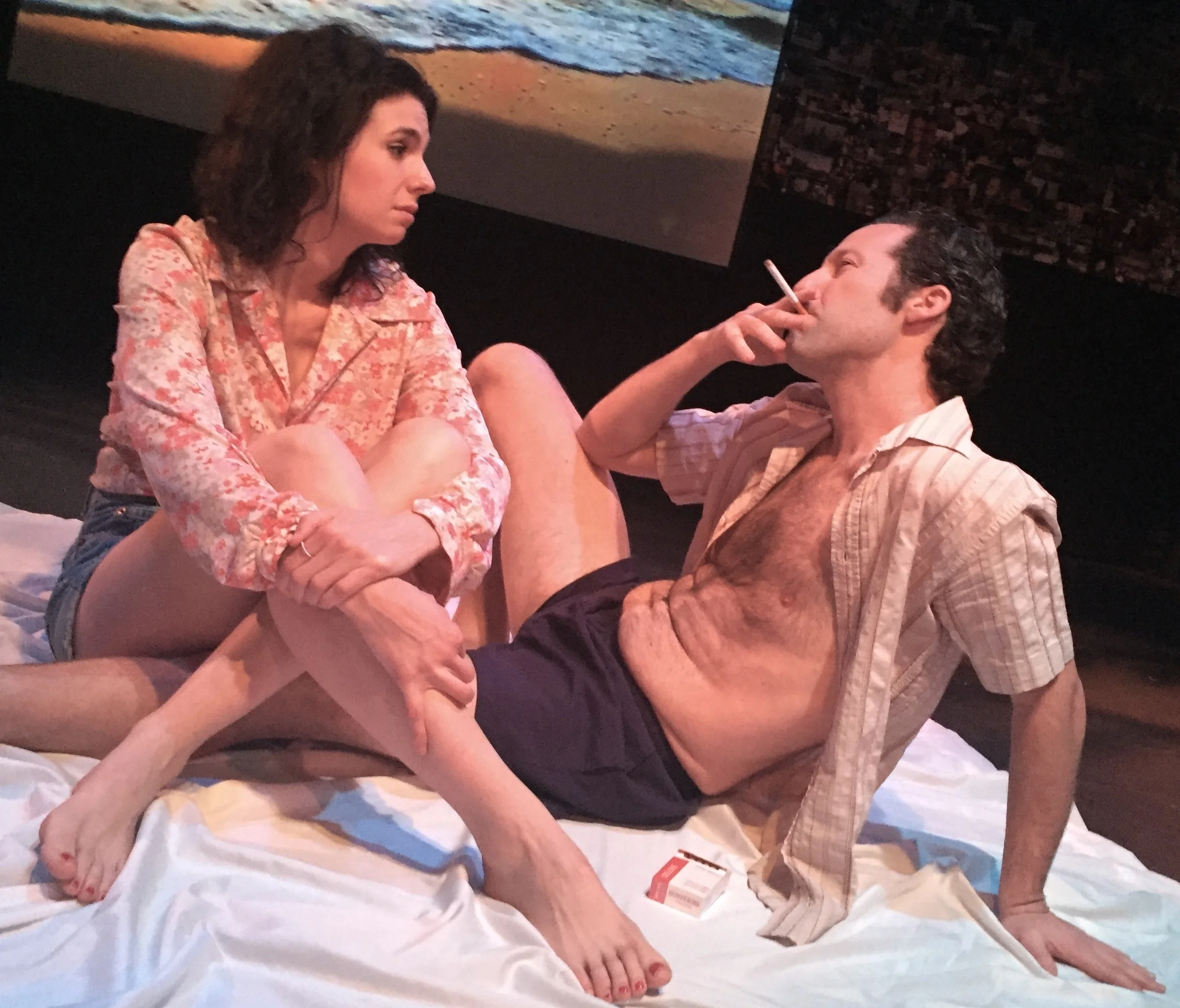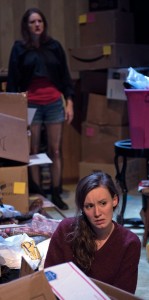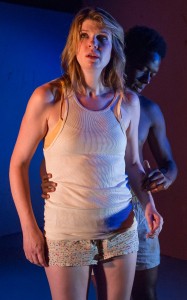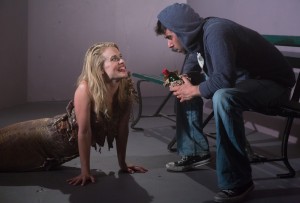Joan Beber’s Dear Jane centers on twin sisters, Julie and Jane, but, in spite of the title, Julie is the focus. Beber’s drama is structured as though Julie (Jenny Piersol) is rehearsing a play about her own life—which she is the star of. Scenes and flashbacks occur from the present to as far back as 1952, and take place in California, New York and the resort town of Puerto Vallarta in Mexico. Julie’s thoughts read like a series of letters between her and her beloved sister.
The Lucky One
In 1922, Alan Alexander (A. A.) Milne’s The Lucky One was originally produced in New York. Milne is best known for his children stories about a good-natured teddy bear, Winnie-the-Pooh, and his friendship with a boy, Christopher Robin (named after Milne's son). Before the extraordinary success of Winnie-the-Pooh, Milne had published three novels and 18 plays. Two of them, Mr. Pim Passes By and The Truth About Blayds, the Mint Theater Company has previously resurrected.
Loose Ends
At the start of Michael Weller’s Loose Ends, splashing waves are projected onto a screen that is surrounded by photo collages as two lovebirds embrace each other on a moonlit Balinese beach in 1970. Sensitive Paul (Loren Bidner) courts distant Susan (Sarah Mae Vink) as he shares with her his exotic adventures in the Peace Corps. Susan childishly responds by retelling the story of when she was 11 years old and had her tonsils cremated. Their passionate moment in seclusion suddenly fizzles out when Susan’s offbeat, chatterbox friend, Janice (Melanie Glancy), finds them with her trusty flashlight. Janice is worried because Susan never returned from her evening walk.
Private Manning Goes to Washington
The title of Stan Richardson’s play Private Manning Goes to Washington suggests that this fictionalized drama is about the life and trials of whistleblower and transgender woman Chelsea Manning. Instead, Manning’s case is used as a jumping-off point for the parallel case of Aaron Swartz (Matt Steiner), a freedom of information activist and Internet prodigy. As the story unfolds, it quickly becomes evident that Manning’s imprisonment acts as a spark for Swartz to get his childhood neighbor, Billy (E. James Ford), to help him write a play about Manning.
Living and Laughing Together
Fans of the hit television sitcom The Golden Girls can now experience Blanche (Cat Greenfield), Rose (Arlee Chadwick), Dorothy (Michael LaMasa) and Sophia (Emmanuelle Zeesman) all over again. But this time these lovely ladies have returned as puppets in Jonathan Rockefeller’s That Golden Girls Show!—A Puppet Parody. Capitalizing on moments from the original television show for loyal fans is where this production shines. Nostalgia quickly sets in upon entering the theater. Scenic and lighting designer David Goldstein marvelously transforms the stage into the women’s popular 1985 Miami living room and kitchen.
A Family’s New Chapter
An Ecuadorian father, Nelson (Anthony Ruiz), struggles to reconnect with his three adult children when his past catches up with him in Vanessa Verduga’s comedy Implications of Cohabitation. Verduga also plays the love child, Sara, who does not relate to her half-siblings, Kevin (Andres de Vengoechea) and Jenny (Connie Saltzman). Their father, Nelson, had an affair with Sara’s mother, Carmen (Adriana Sananes), when she worked as a waitress at a local Ecuadorian restaurant. Sara is a successful attorney with corporate clients, yet she is insecure when it comes to relationships with men. Kevin is an actor, but his father wants him to run the family construction business. Jenny is a punk rock singer who smokes marijuana and is still finding herself. Nelson’s wife, Caitlin, and mother to his two children, Kevin and Jenny, has recently passed away. Now alone, Nelson decides to live with each of his three children in their separate homes with the hope that they will take care of him in his old age. Nelson soon realizes that his children are more concerned about their own lives, and they are not interested in being his caretaker.
The comical misunderstandings throughout this production are amusing, as when Nelson discovers Jenny’s bong, but the humor cannot hide the lack of believability that pops up. In the beginning, when Kevin and Jenny share that they are still grieving over their mother’s death, there are not any memorable, somber moments to express their sadness or loss. They are more focused on viewing their half-sibling, Sara, as an outsider. Sara has a distant relationship with Nelson, while Kevin and Jenny seem to be closer to him.
It does not make sense that Nelson did not first ask his children if he could live with them. It suggests that Nelson has not been around his children for some time now, and he suddenly wants to spend his life with them. When Nelson does show up on their doorsteps, his children are so lost in their own worlds that they do not know what to do with him.
Right before Nelson arrives at Sara’s apartment, Sara’s ex-boyfriend, Jake (James Padric), a gay boxer, staggers into Sarah’s living room drunk. Jake says, “I fucked up. Me and Jean got into a huge argument. And now he’s disappeared.” Jean is Jake’s boyfriend, and Jake goes on about how worried he is about Jean. Padric’s entrance is confusing and it is a stretch to buy that Jake has genuine feelings for Jean and is actually worried about him. Padric does eventually pull off his character splendidly, with physical humor and succinct comedic timing when he mistakenly overdoses on the anti-inflammatory drug Naproxen.
Later, Nelson meets an alcoholic homeless man (David Pendleton) at a bench in a park. The two men get acquainted and eventually Nelson offers the homeless man a beer as they chat. Pendleton was giving a stellar performance until, unfortunately, he forgot his lines and whispered this to Nelson. Fortunately, Ruiz didn’t flinch and continued with his lines until he exited. His accomplished performance from the moment he appears on stage really holds this show together.
Set designer Anna Grigo creates a neat and organized set with a park on the left, an apartment in the middle, and an Ecuadorian restaurant on the right. What does not work is that the apartment is static and does not transform enough to represent each of the children’s homes. The transitions are also noticeably long. A picture is simply replaced on the wall to represent that the set has changed from Sara’s to Kevin’s apartment. When it is supposed to be Jenny’s apartment, some clothes are thrown on the furniture. The interior decorating best suits Sara’s taste and temperament, and it is easily plausible that this is her home. Kevin does not seem successful enough as an actor to afford to live in such a place. Jenny appears more like a squatter or an Airbnb guest in this space.
Even with a two-act structure, Implications of Cohabitation never fully ripens to the point where Nelson is actually living with any of his children. The play gradually takes a turn and focuses more on Sara’s wedding and the participation of her friends and family members. There is probably a great wealth of material that could be further explored by having Nelson live with his children. When telling a family story between two disconnected generations, it can be fascinating to watch how both generations play off of each other’s differences. Director Leni Mendez’s challenge is to bring greater authenticity to this production through natural performances and maintaining the original intention of this story.
Implications of Cohabitation runs until Aug. 26 at the Clurman Theatre (Theatre Row, 410 West 42 St., between 9th and 10th avenues) in Manhattan. Evening performances are at 8 p.m. Wednesday through Saturday and at 7 p.m. on Aug. 23. Tickets cost $20.25. To purchase tickets, call 212-239-6200 or visit sudacastheater.com.
Loss Takes On Many Forms
Holding on to the past can weigh upon a family. In her first play, Keep, Francesca Pazniokas explores how the emotional weight of a missing woman burdens her three sisters. Keep is inspired by her years of struggling to mask an addiction to hoarding. The production centers on a young hoarder, Naomi (Kim Krane), and her older sisters, Jane (Madison Comerzan) and Kara (Jenna D'Angelo). As Jane and Kara attempt to clean Naomi’s cramped apartment, they learn about what happened to their sister, Margo (Leslie Marseglia), who disappeared some years earlier. No, Jane and Kara do not find Margo’s decaying body underneath Naomi’s rug. Instead, they discover how disconnected their sisterhood has become.
Naomi does not sleep much and spends most of her time within a small area of her apartment, surrounded by junk and next to her filthy mattress. Jane and Kara arrive, and the three women blend together. They give bland first impressions as characters and are not easily distinguishable. Shortly after, Jane is revealed as more than a doting, artificial suburbanite who affectionately calls Naomi “Nooni”; she’s a lesbian who is in a relationship with a psychiatrist. Kara takes on a reckless and commanding leadership role and demands that the apartment be cleaned. Meekly, Naomi follows along with uncluttering her apartment and goes in and out of spouting incoherent passages like, “A rabbit, I think. A rabbit kicks a clot of blood and it–or someone boils it. I’m trying to remember. I think it was a rabbit.”
What doesn’t ring true is the sense of an actual intervention like those shown on an episode of A&E’s addictive television show Hoarders. The twist that is offered in Keep does not cure Naomi of her hoarding disorder. Other disorders like attention-deficit/hyperactivity disorder (ADHD), obsessive-compulsive disorder (OCD), obsessive-compulsive personality disorder (OCPD) and depression can be associated with hoarding. It is ambiguous if Naomi is struggling with any of these associated disorders or if she is just schizophrenic or bipolar. Hoarders are likely to be more guarded and attached to their items than Naomi’s passive nature indicates, and so Naomi’s hoarding disorder lacks some credibility. Although director Stephanie C. Cunningham brings out the sense of loss the sister feel, perhaps she could have urged bolder character choices.
The play is supposed to take place somewhere along the East Coast during the transition from winter to spring, but this is also ambiguous. Set designer Alfred Schatz creates a hoarder’s haven, with stacks of unpacked moving boxes, piles of old mail, and random pieces of furniture. It is like an antique store that has been turned into a storage unit. The set becomes enchanting after Margo appears, when lighting designer Cate DiGirolamo transforms the ceiling into a sparkling starry night.
The storytelling techniques used to show how these three sisters deal with the loss of Margo is the real value of this 80-minute production. Though they start out seeming indistinguishable, it becomes clear that Naomi lives in the past, Kara lives in the present, and Jane lives in the future. The distance between the three of them also brings them together because the separation reminds them of the intimacy they all once shared. Only Naomi really knows what happened to Margo, but, through the help of Jane and Kara, Naomi eventually reveals the truth.
Although simple and subtle, the play lands like a character study, without strong motivations from the characters. Because the characters do not coherently or explicitly stand for something, it is the plot that eventually moves the discussion forward. Pazniokas aims to dive deep into America’s “disposable society” and the value of human life, but lands somewhere between vaguely characterizing mental illness and grief.
The production is more successful at conveying how young women cope with isolation and alienation. The sisters’ disconnection is not due to modern technology or even mental illness in Keep, but because these characters have withheld who they really are from one another for so many years. The bonds of sisterhood began disintegrating after Margo left; the absent sister is the only one who frees herself of this burden but is unsuccessful at transforming her sisters—and this is where the true divide lives. Keep reminds theatergoers that the affinity shared between sisters can be powerful and ephemeral.
Keep runs until April 30 at the TGB Theatre (312 West 36 St., between 8th and 9th avenues) in Manhattan. Evening performances are at 8 p.m. Thursday through Saturday; there is an additional performance on April 27 at 8 p.m. There are no matinees. Tickets cost $18. To purchase tickets, call 800-411-8881 or visit BrownPaperTickets.com.
Crossing Into Madness
The filth, danger and enchantment of the South comes alive in Adam Rapp’s Wolf in the River and it all takes place around a fresh mound of earth with intoxicating purple flowers. The Man (Jack Ellis) is a shapechanger and he stands barefoot in the dirt, like he is on a soapbox, and counts each audience member one at a time. He is shirtless and holds his torso firmly as he moves around the room demonstrating his dominance. The shapechanger can supernaturally change from a man, to a wolf, and to a nasty, old woman named Dumptruck Lorna. The Wolf smells a pair of used panties from a canvas sack and examines a muddy sundress, cutoff jean shorts, sneakers and a cell phone. Ghoulish men and women known as the Lost Choir creep around the space and hide in the shadows. Suddenly, a distraught, young woman, Tana Weed (Kate Thulin), runs onto the stage naked, grabs the items and is attacked by the Wolf and Lost Choir.
The production explores Tana’s relationship with her apparent first love, Debo (Maki Borden)—a jovial young man from Benton, Illinois. Lighting designer Masha Tsimring uses the warm light from a worn fridge skillfully to create intimacy as Tana and Debo talk to each other over the phone. Scenic designer Arnulfo Maldonado constructs a psychotic background with black stick figures drawn across plywood walls and a thick rope looming over the stage. On a back wall hangs a picture of Jesus Christ with a green, plastic Christmas garland and red bow.
Tana also experiences a contrasting world of chaos and violence that is ran by Monty Mae Maloney (Xanthe Paige). Monty is a blood collector and uses a cane with an alligator head on top of it even though she walks perfectly well. She is also the girlfriend of Tana’s older brother, Dothan (William Apps). Dothan is a dishonorably discharged veteran who spends his time silently tinkering with electronic gadgets. Monty’s gang consists of Aikin (Karen Eilbacher) and Ansel Pinwood (Mike Swift), who goes by Pin. Aikin appears to be a masculine lesbian and eats the purple flowers to get high. Pin runs onto the stage half-naked with a printed copy of Miley Cyrus’ face taped to a blow-up doll. He has sex with the doll over the mound of dirt. Monty ensures that her crew have their intravenous medical ports working properly so that she can draw blood from them.
Theatergoers experience Tana’s worlds as though they are sitting right next to her, and this intimacy is the real value of this production. When Monty slams Tana’s head into the fridge, audience members might even get fake blood splattered on their clothes. The fresh soil from the center mound of earth and burning incense also brings a sense of smell to these worlds. Tana’s life is exposed, criticized and objectified. Nothing, including Tana’s virginity, is not left unjudged. Under Rapp’s direction, The Flea Theater’s resident volunteer acting company, The Bats, have these worlds come alive in raw form.
Rapp and the cast make bold choices and commit to them, but the challenge is having these choices payoff with theatergoers. The vulgarity in some of the scenes can create distance for theatergoers who are trying to relate to the characters and understand the storyline. It is awkward watching the Wolf engage with audience members when the audience is still just trying to figure out what is going on. The overall aim and vision can be unclear and other markets may not respond to this material.
At the same time there is so much depth to these characters that each of them could have their own play written about them. The issues are rooted more so in the characters and not the plot. Each character’s stand is like figments of Tana’s imagination. The violence, nudity and sexual situations do effectively show the characters’ vulnerability, desperation and fears–even when theatergoers have already seen enough.
Wolf in the River is recommended for theatergoers who want to be challenged and still have the patience to see what this production has to offer at the end. It is not recommended for those seeking a nicely woven and easy-to-swallow story. Thulin’s performance as Tana is solid and her ability to stay in character and be innocent while going through hell is very impressive. Tana’s hunched shoulders and bloody nose suggests that she is timid and defeated, but her determination to leave her hometown and run away with Debo stays present in her eyes. She is not a victim, but a survivor who hides her reality from Debo. The audience is the river and the Wolf says, “You go for miles and your current’s so strong this time a year that the people in this town string ropes across to help folks get to the other side.”
Wolf in the River runs until June 6 at The Flea Theater (41 White St. between Church Street and Broadway) in Manhattan. Evening performances are Monday and Thursday-Saturday at 7 p.m. and select matinee performances are Saturday at 1 p.m. and Sunday at 3 p.m. Tickets range from $20-$100. To purchase tickets, call 212-352-3101 or visit TheFlea.org.
Opposites Attract a Solution
Hard and soft qualities and everything in the middle can characterize a man’s masculinity. Mark Borkowski’s two-act comedy The Head Hunter explores masculinity through the contrast of two cousins who take on life’s challenges. Late 30’s writer Casmir (Trenton Clark) and his rugged, older cousin Salvy (Jay Rivera) come from the same family but occur to be from two different worlds.
The production feels more like a family drama and takes place during a winter in Hoboken, New Jersey in Casmir’s outdated apartment. Casmir’s white refrigerator, stove, and oven could have been from the 1950s. The worn rug, antique writing desk and wooden chair with a missing wheel give the impression that Casmir has not left his apartment in years. Casmir’s bland clothes even looks like he sleeps in them and contrasts with Salvy’s new, stylish clothes. Salvy is also taller, stronger and has more facial hair compared with his younger cousin Casmir. The two men do not appear or sound like they are from the same neighborhood.
Salvy challenges Casmir’s ability to stand up to a movie producer who has the rights to Casmir’s screenplay. Casmir mistakenly signed his rights away and does not have enough money to hire a lawyer. Casmir says, “You're right, I was desperate. I needed the money. I needed...the attention. Somebody was recognizin' me.” Casmir and Salvy conspire to get the rights back to Casmir’s script. Casmir prefers to take a polite, gentleman approach when faced with difficult situations and Salvy resorts to brute force. When Casmir finds out that Salvy is a head hunter who decapitates people for the mob, Casmir says, “No, how do we come from the same bloodline?” Salvy says, “What, you sayin' you better [than] me?! ‘Bloodline.’ Hey, don't forget, the same guy who made Christ also made the devil. So go figure. ‘Bloodline.’” Great dialogue like these lines can be heard throughout the play and the value of the production is in Borkowski’s writing.
The writing is worthy of traveling to other markets and easily relates to the modern world. The subject matter is not only limited to New York City and our current time but has universal meaning that can apply to future generations. Borkowski’s writing sheds insight into the varying moral and ethical principles that people adhere by. Casmir says with great honor that his deceased father had pride and Salvy says, “Pride. I love that fuckin' word. Ya know what that word is? It's an excuse, another excuse for a man to keep himself down.” Casmir counters by stating that his father still had a conscience. Salvy later goes on to challenge Casmir’s masculinity and says, “'Cause [you're] soft. Your insides, they gettin' ripe. [You're] ready to be plucked. Forget that, you are plucked. Like a tomato. It hangs nobly on the tree. Whole and hard, as if it's sayin' don't fuck wit me. It gets soft, it falls off the tree and gets squashed. That's what happenin', my friend. You are getting squashed.” The dialogue is brilliant, authentic, thought-provoking and allows audiences to reflect on their own lives.
Director Richard Gekko has an opportunity to insert his own vision and interpretation of the material. It would be interesting to witness Gekko’s slant on the text. Gekko could also improve the overall pacing of the production. The Head Hunter struggles with timing and could be more intentional. For example, the intermission seems to go on too long and could be shortened. Likewise, when Casmir steps out onto the roof, audiences might start to wonder when Casmir will return. Lastly, Rivera could slow down and take some deep breaths before delivering his lines so his performance has time to sink in with audience members. On the other hand, Clark’s timing as Casmir was on point when he spoke and his performance did not feel rushed and scrambled.
When entering the Abingdon Theatre Complex, a poster for The Head Hunter is not visible. The Dorothy Strelsin Theatre is on the second floor and is not easily accessible via the staircase, but there is an elevator. The theater is intimate and audience members feel like they are sitting in the living room of Casmir’s apartment.
The Head Hunter is recommended for theatergoers who love great writing and appreciate seeing family members from different backgrounds coming together to solve a problem. Borkowski captures the natural voice of a broken writer and his criminal cousin. Audiences are able to grasp where each character stands as the plot develops. The contrast between the characters is like looking at two sides of a coin. The vision is clear and the aim is accomplished. The writing carries the show and theatergoers will be keen to see any other productions that Borkowski writes.
The Head Hunter runs until Nov. 28 at The Dorothy Strelsin Theatre in the Abingdon Theatre Complex (312 West 36 St., 2nd Fl., between 8th and 9th Aves.) in Manhattan. Evening performances are Thursday-Saturday at 8 p.m. and matinee performances are Saturday at 2 p.m. and Sunday at 2:30 p.m. Advance evening tickets are $35 and matinee tickets are $20. To purchase tickets, call 212-868-4444 or visit SmartTix.com.
No Pot of Gold
An 8,000-year-old Irish fairy is not to be mistaken for a leprechaun in James McLindon’s Comes a Faery. The production opens with a grown woman (Meghan St. Thomas) acting like an 8-year-old girl Siobhan as she plays with a doll and toy truck. Though it is noted in the script for “a very youthful-looking adult [to] play Siobhan,” the casting does not work. St. Thomas sounds and behaves like a whiny child and looks more like an adolescent who is at the beginning stages of puberty. The mismatch in casting distracts theatergoers from acknowledging St. Thomas’ solid performance and her ability to carry the production. The director Shaun Peknic could have taken the liberty to cast a younger woman to portray the child Siobhan. On the other hand, Josh Marcantel is well cast as the Irish fairy Seaneen. Comes a Faery attempts to capture the emotional and mental impacts that a child experiences when their mother is away overseas serving in the armed forces.
The play takes place in an apartment in Cambridge, Massachusetts and the set design by Kyu Shin is modest and homely with a loveseat, lamp and nightstand. In the background appears to be a wooden stage with three boxes wrapped in beige paper that have light cursive writing. The brown coloring used for the wording is not dark enough to clearly understand what is written. The two large walls on the backstage appear to be a large book and they also have the beige paper with brown wording on them. The light and dark blue and white zebra print floor is distracting and it does not exactly match the blue and white blankets on the couch. The audience members were further distracted from the actors’ performances when a cockroach ran across the stage and St. Thomas killed it by dropping a book on the cockroach. Marcantel tried to sweep the dead cockroach under the stage with his foot, and the experience left a lasting impression with the audience.
Siobhan is fixated on seeing her mother again and is easily manipulated by Seaneen, who has convinced Siobhan that everyone in her life will leave her. Seaneen is never clearly defined as actually being a real, live fairy or Siobhan’s imaginary playmate. This is one example of how McLindon leaves it up to audiences to decide for themselves if Seaneen is real or not. The lack of clarity does not add much to the plot or Seaneen’s character development and actually creates confusion. Siobhan’s pediatrician Dr. Neery (Lori Kee) cannot clearly diagnose Siobhan’s condition or Siobhan’s relationship with Seaneen. When Seaneen convinces Siobhan to catch Dr. Neery on fire with a burning newspaper, Dr. Neery writes off Siobhan’s failed attempt and says, “That which doesn’t kill you makes for a great story later.” Dr. Neery believes that Siobhan could be experiencing conduct disorder or possibly psychosis. Siobhan’s guardian and Aunt Katie (Michaela Reggio) thinks that it is normal for 8-year-old girls like Siobhan to have an imaginary Irish fairy as a best friend. Katie’s artist boyfriend Raphael (Benjamin Miller) is Siobhan’s only healthy, male role model and he appears to be the only person who can actually relate to her.
The value of the production rests in its opportunity to have a greater conversation about children who are raised by others while their biological parents serve in a war. However, the lack of clarity and confusing casting has McLindon fall short in clearly delivering a message. Simply leaving it up to theatergoers to decide what is happening or what the point is, suggests that the material is underdeveloped. The show runs for 120 minutes with an intermission and feels like it lags. A matured production will have theatergoers wanting more and not just waiting for the show to end so that they can go home.
Comes a Faery misses it mark and does not deliver to its full potential. The production would be much more powerful if St. Thomas were cast as Aunt Katie and a teenager played Siobhan. As strong performers, St. Thomas and Miller could compliment each other’s performances if they were paired together as boyfriend and girlfriend. Reggio portrays Katie as a victim of her own circumstances and instead of having theatergoers feel empathy for Katie, she occurs as annoying and tiresome to watch. Miller stands out in comparison to Reggio when they are partnered together. Miller’s energy feels like a sitcom actor. Comes a Faery is not recommended unless theatergoers are willing to overlook its shortcomings and focus on the dynamic performances by St. Thomas, Miller and Marcantel.
Comes a Faery runs until Oct. 24 at the New Ohio Theatre (154 Christopher St. between Greenwich and Washington Sts.) in Manhattan. Evening performances are Friday and Saturday at 8 p.m. Tickets are $18 and can be purchased by calling 347-524-0514 or visiting www.nylonfusion.org.
Fairy Tales with Scary Endings
German brothers Jacob and Wilhelm Grimm are best known for writing Cinderella, Sleeping Beauty, Snow White and many other famous fairy tales. There was also a darker side to the Grimms’ earlier works that included child abuse, incest and anti-Semitism. The short stories in Martin McDonagh’s The Pillowman echo the Grimms’ twisted side. The Pillowman takes place in a totalitarian state and deals with childhood abuse. The characters rarely experience a "Disney" fairy tale ending. Audiences are sure to be amused and horrified as this story unfolds.
The production opens with a proclamation from writer Katurian (Kirk Gostkowski) trying to weasel his way out of being tortured: “The only duty of a storyteller is to tell a story.” Detectives Tupolski (Deven Anderson) and Ariel (Paul Terkel) do not buy Katurian’s noble stand as a writer. Katurian recites one of his gruesome short stories The Tale of the Town on the River about a poor, little boy with no shoes who is bullied by the local children. One day the little boy offers a hooded driver a piece of the boy’s sandwich. The driver repays the boy by using a meat cleaver to cut off all of the boy’s toes on his right foot. The driver is supposed to be the Pied Piper and he is riding into the German town of Hamelin to lure away all of the children with his magical flute. Due to the boy’s missing toes, he is unable to walk as fast as the other children. The little boy is not taken away by the Pied Piper and becomes a Hamelin survivor.
Detectives Tupolski and Ariel claim they found the toes of a dead, Jewish boy in Katurian’s home. The detectives assert there is a connection between the crippled boy in Katurian’s short story "The Tale of the Town on the River" and the Jewish boy’s death. A string of other child deaths could be tied to Katurian’s violent short stories. Out of the four hundred stories Katurian wrote, he says “maybe ten or twenty have children in [them].” Audiences soon discover Katurian’s inspiration for these morbid stories in a film directed by David Rey. The film discloses the horrific abuse and neglect Katurian’s brother Michal (Kyle Kirkpatrick) experienced by their parents—which permanently left Michal “slow to get things.”
The value of this production is its ability to creatively show the effects of childhood abuse through the eyes of Katurian. As the main character and a family member, Katurian’s perspective is unique because he was never abused. His parents loved him and encouraged him to be a great writer. Audiences are able to connect with Michal’s suffering through Katurian’s love for his brother. Likewise, it is Gostkowski’s stellar performance as Katurian that carries this show. Katurian appears clever and likable, and at the same time, he feels so slippery. Audiences are left wondering if Katurian is telling the truth or lying about the murdered children in his stories.
Anderson is not fully self-expressed and authentic in his portrayal of Detective Tupolski. Director Greg Cicchino could have Anderson face the audience more often and project his voice so that audience members can get related to Anderson’s character during his opening lines. Instead of gauging the audience’s approval of his performance, Anderson could be more powerful by fully stepping into his role as the lead detective. As Detective Tupolski’s partner, Terkel maneuvers through the action scenes seamlessly in his performance of Detective Ariel. When Terkel slams Gostkowski’s head against the wall, the audience gains a real sense of what it is like to live in a totalitarian state. However, Terkel’s frequent use of herbal cigarettes starts to become a distraction and eventually does not add to his character. Kirkpatrick’s performance as Katurian’s mentally challenged brother Michal adds comic relief when Michal goes on about having an itchy butt.
Production designer Aaron Gonzalez created a simple, gray set that feels like a cross between a makeshift jail cell and an abandoned office during the height of the Cold War. The Chain Theatre is a fresh, friendly, intimate space with a gallery exhibition in the lobby by Tyler Hughes. The seating is connected, and if someone in your row is fidgeting throughout the show, their movements can be felt by others sitting in the same row. There is also simulated gunfire during the production for those who are sensitive to noise.
If you have not had a chance to see a performance of McDonagh’s award-winning play The Pillowman, then this is an opportunity to do so. Since its first public reading at London's Finborough Theatre in 1995, the play has traveled around the world. The use of universal, childhood fairy tales allows for generations to easily connect with the material. It is McDonagh’s take on childhood abuse that is most startling and thought-provoking for audiences to discover.
The Pillowman runs until Oct. 3 at the Chain Theatre (21-28 45th Rd. between 21 and 23 Sts.) in Long Island City, Queens. Evening performances are Wednesday-Saturday at 8 p.m. and matinee performances are Saturday and Sunday at 2 p.m. Tickets are $18 in advance and $20 at the door and can be purchased by calling 866-811-4111 or visiting www.variationstheatregroup.com.
A Slanted Perspective
The reality in New York City and the rest of the modern world can seem absurd, morbid and mysterious from one minute to the next. Troy Deutsch’s In a Tilted Place shows just how strange life can really get. The production is a series of nine outlandish short plays, or wild scenes, and opens with a giddy, young woman (Cassandra Stokes-Wylie) retelling her “very, very real” dream. In her dream, she saw herself as a spirited girl, who had faith in God and ate ice cream at her local Dairy Queen. In her small town she “[biked] down Main Street with streamers on [her] handlebars.” Her story starts to take an unexpected turn when she shares about her first love, an “All-American quarterback.” She had group sex with her football player boyfriend and a brown, squirrel mascot who had “actual squirrel fur,” small paws and human eyes.
These creepy twists and turns are consistent throughout In a Tilted Place, and theatergoers wonder what this show is trying to say about the world we live in. The characters are in environments that seem normal at first and then their circumstances become bizarre and surreal. The female characters are often portrayed as controlling, manipulative, sex-crazed maniacs and the men are aloof, unavailable, drunk or driven mad by women. The value of this production is its ability to present ordinary, day-to-day life as uncanny, odd and whimsical. In a Titled Place is able to disgust, enlighten and provoke audience members.
In the second play, Chanel Chance, a lonely, desperate, young woman Ella (Kelsie Jepsen) sits in a cafe and tries to read Donna Tartt’s Pulitzer Prize-winning novel, “The Goldfinch.” Ella catches the gaze of a young man (Ronald Peet) sitting at another table and asks, “Are you someone? I’m sorry. But I noticed… Are you watching me? I’ve been looking over here and…” Their quirky exchange quickly becomes heated and even more awkward when Ella discovers that her own father has been paying this young man to spy on her. Ella forcefully kisses the man and demands, “Just look at me. Just smell me. Smell me. Smell my neck. Smell it. Smell it.” It is like watching a weirder version of an episode from “The Twilight Zone.”
This is Peet’s opening scene and his heavenly voice is abruptly overshadowed by Jepsen’s frenzied performance as she dominates the space. Peet is an exceptional actor from the Bahamas who graduated from the Tisch School of the Arts Drama program at New York University. Directors Ashley Brooke Monroe and Courtney Ulrich could balance out this scene by having Peet speak directly to the audience more often and have Jepsen slow down a bit. In a later play, Glowing Dinoflagellates, Peet plays naive and impressionable Benjamin. Benjamin is seduced by a powerful, horny, middle-aged woman (Pamela Shaw) to stay at her vacant inn on a cliff. Peet and Shaw’s authentic chemistry and first-rate performances complement each other extremely well and create a solid foundation for other actors to shine. Sex slaves (Sean Kazarian and Michael Kingsbaker) generously contribute to heightening this scene by bringing comic relief as they ramble on in unison about their torturous stay at the inn.
This production’s material is too insular and will likely not travel beyond audiences who enjoy fringe theater. In Brown Fish, a young woman sits on a bench in a concrete park and confesses to her male friend about her roommate’s poop cabin. She describes the poop cabin as “A brown, self-induced, feces log cabin. Like from pioneer days. But the logs, instead of wood, were made of poop.” Wider audiences may not appreciate this production’s unconventional subject matter and style.
The set design by Kate Noll is uncomplicated with a few pieces of furniture and gray, bland walls that look like concrete. Viewers get the sense that these characters exist between a rock and a hard spot. It is like watching a group of people living in an emergency exit hallway in the basement of a skyscraper, and they do not know that the building is on fire. This minimalistic approach is not distracting and allows for audiences to focus solely on the performances. The simplicity works when a mermaid (Rachel Moulton) slowly drags herself across the floor and onto the stage in Call Me Daryl Hannah. Audiences are captivated watching her struggle as she pulls her body and huge fin across the bare, hard surfaces to meet a young, drunk man (Kingsbaker) sitting on a park bench.
In a Tilted Place relies on shocking and unusual subject matter to create tension and mystery. Audience members can turn into distant bystanders who are merely observing. As observers, they can become disconnected from these unique characters and not know how to relate. A clearer overall aim and vision could create a deeper appreciation for this production’s willingness to transcend traditional ideas.
In a Tilted Place runs until Aug. 30 at the IRT Theater (third floor of 154 Christopher St. between Washington and Greenwich Sts. in Manhattan). Evening performances are Monday, Friday and Saturday at 8 p.m. and matinee performances are Sunday at 3 p.m. Tickets are $18 and can be purchased by calling 800-838-3006 or visiting BrownPaperTickets.com.
























